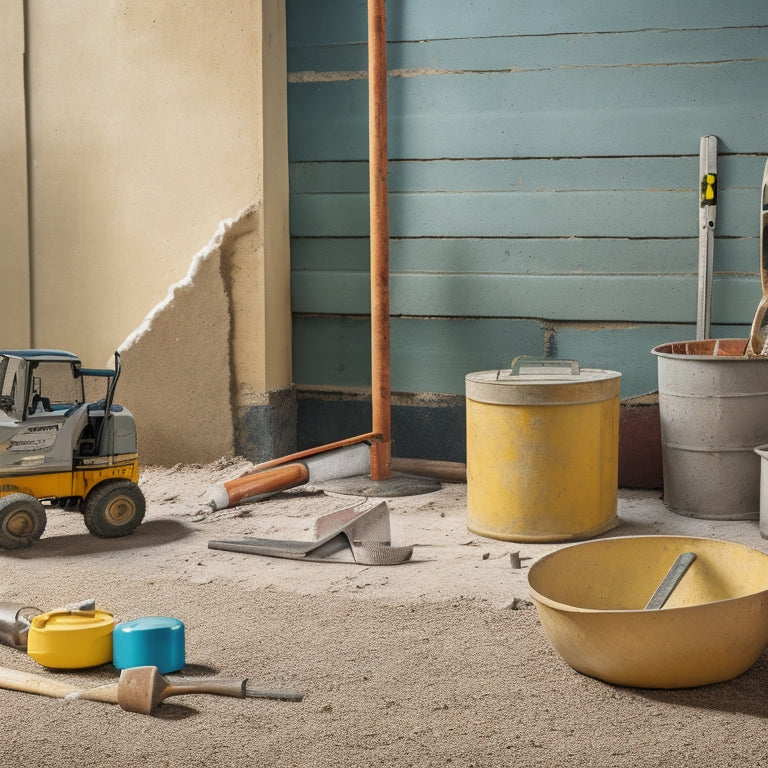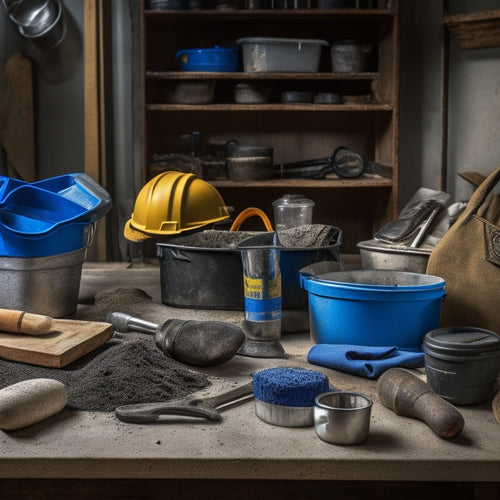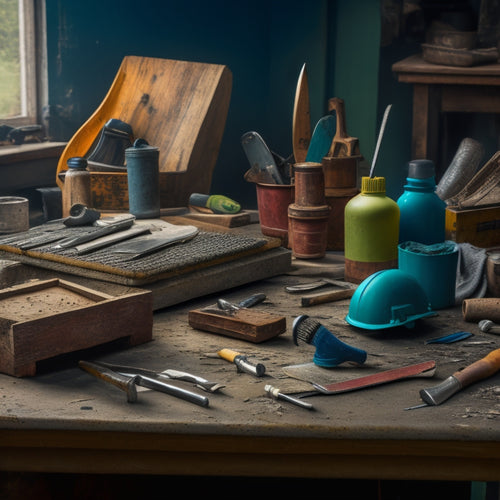
Why You Need These Concrete Wall Building Tools
Share
You'll greatly reduce the risk of accidents, errors, and structural weaknesses in your concrete wall projects by ensuring you have the right tools for the job. From essential safety gear like hard hats and gloves to measuring and marking tools like laser levels and chalk lines, each device plays a critical role in achieving a strong and durable wall. Omitting or substituting even a single critical tool can have devastating consequences, such as a collapsed wall or a workplace injury. As you explore the extensive groups of concrete wall building tools, you'll discover how each one contributes to a successful project, and uncover the secrets to building walls that stand the test of time.
Key Takeaways
• Ensuring safety on the job site is crucial, and having the right tools, such as personal protective gear and first-aid kits, prevents accidents and injuries.
• Accurate measurements and markings are vital for a well-built concrete wall, and tools like tape measures and laser levels guarantee precision.
• Proper mixing and pouring techniques are critical for strong, durable concrete walls, and tools like concrete mixers and pouring buckets facilitate this process.
• Compaction and consolidation tools, including vibratory plate compactors and hand tampers, eliminate air pockets and ensure a solid foundation.
• Using the right finishing tools, such as trowels and edgers, creates a smooth, even surface, and curing equipment protects the concrete from environmental damage.
Essential Safety Equipment Checklist
Before you begin building a concrete wall, make sure you have the following vital safety equipment to prevent injuries and guarantee a successful project.
You'll need personal protective gear like hard hats, safety glasses, and earplugs to shield yourself from falling objects, debris, and loud machinery. Steel-toed boots with good traction are a must to prevent slips and falls on the job site. Don't forget gloves with grip to provide a secure hold on tools and materials.
Invest in a dust mask or respirator to protect yourself from inhaling concrete dust and other airborne particles. A first-aid kit should always be on hand in case of accidents. It's also essential to have a fire extinguisher nearby in case of emergencies.
Make sure you have a reliable means of communication, such as a two-way radio, to stay in touch with your team. Finally, wear high-visibility vests to increase your visibility on the job site.
With this safety gear, you'll be well-equipped to tackle your concrete wall project with confidence and authority. Remember, safety always comes first, so don't compromise on these vital items.
Measuring and Marking Tools
You'll need a set of precise measuring and marking tools to accurately layout and construct your concrete wall, including a 100-foot tape measure, a laser level, and a chalk line reel. These tools will help you achieve precise measurements, guaranteeing your wall is level, plumb, and square.
A high-quality tape measure will allow you to take accurate readings, while a laser level will project a level line or dot, assuring your wall is perfectly aligned. A chalk line reel is essential for marking straight lines on the subgrade or forms, guaranteeing your concrete pour is accurate.
When selecting tape measures, look for ones with sturdy hooks, clear markings, and a durable casing. Chalk lines should have a consistent, vibrant color and a reel that's easy to wind and rewind.
Don't settle for low-quality tools that can lead to errors and costly rework. Invest in superior measuring and marking tools to guarantee your concrete wall is built to last.
With these essentials in your toolkit, you'll be confident in your ability to construct a precision-built concrete wall that meets your project's requirements.
Mixing and Pouring Essentials
With your concrete wall's layout and measurements precisely marked, it's time to prepare the mixing and pouring essentials to bring your design to life.
Now, you'll need to focus on perfecting your mixing techniques to guarantee a consistent, high-quality concrete mix. Invest in a heavy-duty concrete mixer that can handle large batches, and consider using a mixing stick or paddle to scrape the sides and bottom of the mixer drum. This guarantees all ingredients are well incorporated, reducing the risk of weak spots in your wall.
For pouring, you'll need a sturdy, reliable pouring method. A concrete pump or conveyor belt can streamline the process, especially for large or complex projects. If you're working on a smaller scale, a wheelbarrow or bucket can suffice. Regardless of the method, make sure you're prepared to pour concrete quickly and efficiently, as it sets rapidly.
With the right mixing and pouring essentials, you'll be able to achieve a strong, durable concrete wall that meets your design specifications. By mastering these critical steps, you'll be well on your way to building a concrete wall that stands the test of time.
Concrete Finishing Tools Required
As you move on to the finishing stage of your concrete wall project, you'll need the right tools to achieve a smooth, even surface.
You'll require a set of concrete finishing tools to address imperfections, create clean edges, and add the final touches.
Smoothing Out Imperfections
To achieve a smooth, even surface, you're likely to need a range of concrete finishing tools to tackle imperfections that arise during the curing process.
Surface preparation is essential in ensuring a flawless finish, and that's where tools like trowels, floats, and darbies come in. These tools help to remove excess material, fill in gaps, and create a uniform texture, setting the stage for further refinement.
For texture enhancement, you'll need tools that can manipulate the concrete's surface. Edgers, for instance, help to create a clean, defined edge, while jointers and groovers enable you to add subtle textures and patterns.
Edging and Shaping Tools
You'll turn to edging and shaping tools to refine the concrete's perimeter and create a polished, professional-looking finish. These tools are essential for attaining precise edging techniques and shaping methods that elevate your concrete wall's overall appearance.
When it comes to edging and shaping, you'll need:
-
Edgers: These versatile tools allow you to create clean, defined edges and can be used to create decorative borders or patterns.
-
Trowels: Perfect for shaping and refining the concrete's surface, trowels come in various shapes and sizes to suit your specific needs.
-
Floats: These tools help to smooth and flatten the concrete, preparing it for further finishing techniques.
- Jointers: Used to create control joints in the concrete, jointers help to prevent cracking and guarantee a more stable structure.
Finishing With Perfection
With the concrete's surface prepared, it's time to bring out the big guns: specialized finishing tools that will take your wall from rough to refined. You'll need a range of tools to achieve the desired surface treatments and decorative finishes. A bull float is essential for applying a smooth, even finish, while a darby will help remove any air pockets or imperfections. For a more textured look, a fresno or a magnesium float can be used to create a subtle, mottled effect.
When it comes to decorative finishes, you'll want to invest in specialized tools like stamps, stencils, or texture mats. These will allow you to create intricate patterns, designs, or even replicate natural materials like stone or wood.
Don't forget about edging tools, like an edger or a jointer, which will help create crisp, clean lines and joints. With the right finishing tools, you'll be able to achieve a professional-grade finish that showcases your skills and attention to detail.
Block Cutting and Shaping Tools
Your concrete wall building project requires precise block cutting and shaping tools to guarantee accurate fits and clean lines. Without them, you risk compromising the structural integrity and aesthetic appeal of your project. As you work with different block types, you'll need to adapt your cutting techniques to achieve the desired results.
Here are some essential block cutting and shaping tools you should have in your arsenal:
-
Diamond-blade saws for making precise cuts in concrete blocks, pavers, and slabs
-
Block chisels for splitting and shaping blocks to fit around corners, curves, and irregularities
-
Grinders and sanders for smoothing out rough edges and surfaces
- Trowels and edgers for applying and shaping mortar to achieve clean lines and joints
These tools will enable you to work efficiently and effectively, ensuring that your concrete wall building project turns out strong, durable, and visually appealing.
Compaction and Consolidation Tools
When you're building a concrete wall, you'll need to guarantee the mix is properly compacted and consolidated to achieve the required strength and durability.
You'll use compaction and consolidation tools to remove air pockets and excess water, and to tightly pack the aggregate particles together.
You'll find that vibratory plate compactors and hand tamper tools are essential for getting the job done efficiently and effectively.
Vibratory Plate Compactors
You'll typically employ vibratory plate compactors to densify and stabilize freshly laid concrete, guaranteeing a uniform, solid foundation for your structure. These machines are essential for achieving peak compaction, which is critical for preventing settlement cracks and guaranteeing the long-term durability of your concrete walls.
By using vibratory plate compactors, you'll reap several benefits, including:
-
Improved surface density, resulting in a stronger and more durable concrete slab
-
Reduced risk of settlement cracks and structural damage
-
Enhanced stability and uniformity of the concrete foundation
- Increased efficiency and productivity, as these machines can compact large areas quickly and effectively
In addition to their benefits, it's also important to prioritize vibratory plate compactors maintenance to guarantee peak performance and extend their lifespan.
Regular maintenance tasks include checking and replacing worn-out parts, lubricating moving components, and performing routine inspections to detect any potential issues.
Hand Tamper Tools
Hand tamper tools, designed for compaction and consolidation, provide a vital means of achieving uniform density and preventing air pockets in freshly poured concrete, especially in areas inaccessible to larger machinery. These tools are fundamental for guaranteeing the structural integrity of your concrete walls. By using hand tamper tools, you'll reap several benefits, including improved concrete strength, reduced settlement, and increased durability.
Here's a breakdown of the hand tamper benefits and techniques:
| Hand Tamper Benefits | Techniques | Results |
|---|---|---|
| Uniform density | Apply gentle to moderate pressure | Eliminate air pockets and settlement |
| Improved strength | Use a consistent, overlapping pattern | Enhance concrete's load-bearing capacity |
| Increased durability | Compact in multiple directions | Reduce cracking and wear |
When using hand tamper tools, it is important to employ proper techniques to achieve the best results. By applying gentle to moderate pressure and using a consistent, overlapping pattern, you'll make sure that your concrete walls meet the required standards. Remember, hand tamper tools are an indispensable part of your concrete wall building arsenal, providing the precision and control you need to create strong, durable structures.
Concrete Reinforcement Materials
Concrete reinforcement materials, such as rebar, fiber mesh, and wire mesh, play a crucial role in enhancing the strength, durability, and overall performance of your concrete wall structure. These materials are essential in providing additional support to your walls, ensuring they can withstand external forces like wind, earthquakes, and heavy loads.
By incorporating reinforcement materials into your construction process, you'll be able to create a more robust and long-lasting structure.
Here are some key benefits of using concrete reinforcement materials:
-
Improved tensile strength: Rebar and wire mesh help to absorb tension and resist cracking, making your walls more resistant to damage.
-
Enhanced durability: Fiber mesh and rebar reduce the risk of shrinkage cracks, ensuring your walls remain stable over time.
-
Increased load-bearing capacity: By distributing weight more evenly, reinforcement materials enable your walls to support heavier loads.
- Better resistance to natural disasters: By adding strength and stability, reinforcement materials help your walls withstand extreme weather conditions and seismic activity.
Formwork and Molding Tools
With the reinforcement materials in place, your focus now shifts to shaping and molding your concrete wall structure using formwork and molding tools, which are essential for achieving the desired shape, size, and finish.
You'll need to select the right formwork techniques to guarantee your wall meets the project's specifications. This involves choosing the appropriate molding materials, such as plywood, steel, or aluminum, that can withstand the pressure of the concrete.
Formwork techniques include designing and building the formwork structure, preparing the surface for concrete pouring, and confirming the formwork is level and plumb.
You'll also need to take into account the type of molding materials to use, depending on the wall's design and functional requirements. For instance, you may opt for steel formwork for high-rise buildings or plywood for residential projects.
By mastering formwork techniques and selecting the right molding materials, you'll be able to achieve a high-quality concrete wall structure that meets your project's demands.
With the right formwork and molding tools, you'll be able to shape and mold your concrete wall structure with precision and accuracy.
Cleaning and Curing Equipment
You'll need to invest in a range of cleaning and curing equipment to guarantee your freshly poured concrete wall structure achieves its full strength and durability. This equipment is vital for removing excess concrete, dirt, and other contaminants that can compromise the integrity of your wall.
By using the right cleaning techniques and curing methods, you'll be able to produce a strong, long-lasting structure that meets your project's requirements.
Here are some essential cleaning and curing tools you'll need:
-
Pressure washers and spray nozzles to remove excess concrete and dirt
-
Brooms and scrub brushes for manual cleaning of surfaces
-
Curing compounds and sealers to protect the concrete from the elements
- Tamping tools and finishing equipment to achieve a smooth, even finish
Frequently Asked Questions
Can I Use a Regular Drill for Mixing Concrete?
Can you use a regular drill for mixing concrete?
Not effectively, you can't. Regular drills lack the torque and speed to handle thick, heavy concrete mixes.
You'll need a drill specifically designed for mixing concrete, like a paddle mixer or a heavy-duty drill with a mixing bit.
These drill types are built for mixing techniques that require high torque and speed, ensuring a consistent, lump-free mix that'll make your concrete wall building projects a success.
Do I Need to Cure Concrete in Cold Weather?
"When in Rome, do as the Romans do" - in this case, adapt to the cold weather conditions.
You're right to wonder if you need to maintain concrete in cold weather. The answer is yes, absolutely!
Cold weather can slow down the curing process, affecting concrete strength.
To manage this, focus on concrete temperature management, keeping it above 50°F (10°C) during the initial 24-48 hours.
This guarantees proper hydration and strength development, so don't take any chances - prioritize cold weather curing.
What Is the Best Way to Dispose of Leftover Concrete?
When you're left with excess concrete, you'll need to dispose of it responsibly. You can't just dump it anywhere, as it can harm the environment.
Instead, consider concrete recycling, which involves crushing and reusing the material.
Other disposal methods include donating it to local construction projects or disposing of it through licensed facilities.
You'll need to follow local regulations and guidelines to guarantee you're handling leftover concrete correctly.
Can I Use Plywood as a Substitute for Formwork?
You're trying to find a shortcut, like a master chef substituting ingredients on the fly.
But, can you use plywood as a substitute for formwork? While plywood might seem like a viable alternative, its durability is a major concern.
As a formwork alternative, plywood can warp or degrade under the weight and moisture of freshly poured concrete, compromising the structural integrity of your wall.
It's better to stick with proven formwork materials to guarantee a strong, long-lasting concrete structure.
How Long Does It Take for Concrete to Fully Cure?
You'll want to understand the concrete curing process to guarantee your walls are strong and durable.
Factors affecting curing, such as temperature, humidity, and mix design, impact the time it takes for concrete to fully cure.
Typically, concrete reaches 70% strength in 7-10 days, but it can take up to 28 days to fully cure.
You'll need to carefully monitor and control these factors to achieve the best results, ensuring your concrete walls can withstand the test of time.
Conclusion
You've made it to the end of this thorough guide to concrete wall building tools.
Research suggests that using the right tools can increase construction speed by up to 30%.
With these essentials in your arsenal, you'll not only meet but exceed project deadlines.
Remember, investing in quality tools pays off in the long run - it's a no-brainer.
Related Posts
-

5 Tools Needed for Quick Fix Concrete Mixing
You'll need five essential tools to tackle a quick fix concrete mixing project efficiently. First, you'll require a s...
-

Must-Have Handheld Tools for Concrete Repair
When tackling a concrete repair project, it is crucial to have the right handheld tools to achieve a professional fin...
-

Concrete Foundation Building Tools for Homeowners' Success
As you start your concrete foundation building project, it is vital to have the right tools to guarantee success. You...


